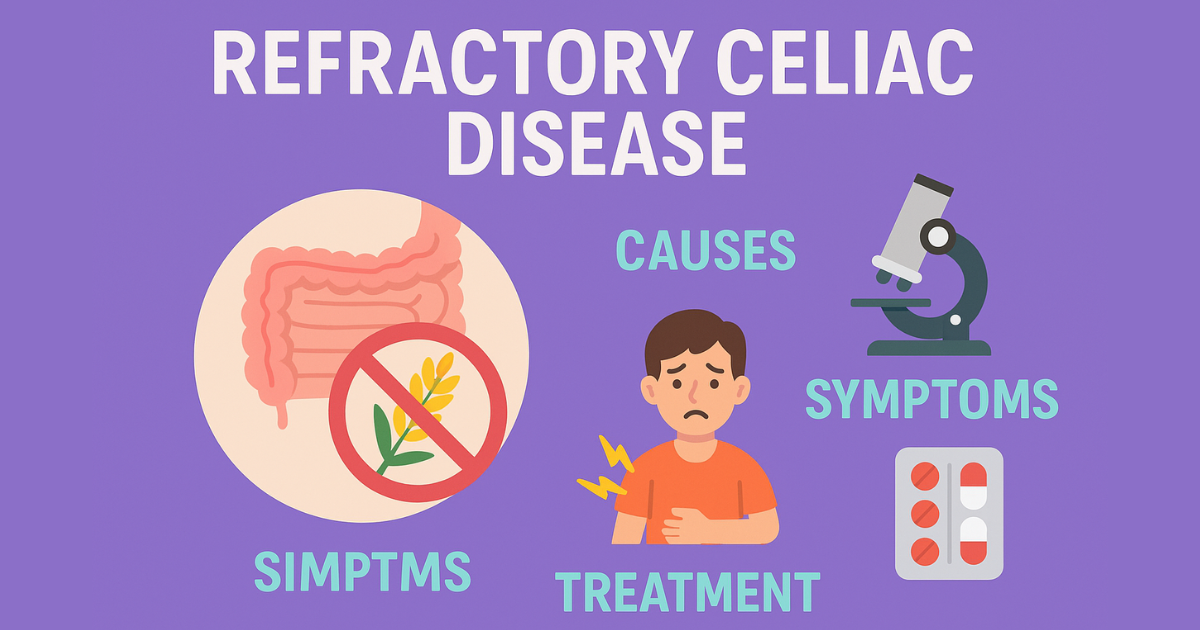Most people with celiac disease start to feel better once they remove gluten from their diet. But what happens when symptoms don’t go away—no matter how strict the diet is? This is when doctors may suspect something more serious: refractory celiac disease.
This rare condition affects a small number of people with celiac disease. It means the body continues to damage the small intestine even after gluten has been completely removed. This can lead to serious health problems like weight loss, diarrhea, and even cancer if left untreated.
Understanding refractory celiac disease is important for anyone living with celiac or supporting someone who is. In this post, we’ll break down what it is, who gets it, and how it’s treated—using clear and simple language that anyone can follow.
What Is Refractory Celiac Disease?
Refractory celiac disease is a rare and more severe form of celiac disease. It happens when a person’s symptoms continue or return even after following a strict gluten-free diet for at least 6 to 12 months. This means the body is still attacking the small intestine as if gluten were still present—even when it’s not.
In classic celiac disease, removing gluten usually allows the gut to heal. But in refractory cases, the damage continues. The villi (tiny finger-like parts of the small intestine that absorb nutrients) stay flattened. This makes it hard for the body to take in the nutrients it needs.
Doctors divide refractory celiac disease into two main types: Type I and Type II. Type I is milder and often responds to treatment. Type II is more serious and can sometimes lead to cancer of the intestine if not managed carefully. We’ll explore these types more in the next section.
Who Gets Refractory Celiac Disease?
Refractory celiac disease doesn’t affect everyone with celiac. In fact, it’s very rare. Most people with celiac do well after going gluten-free. But for a small number—less than 1 in 100—it doesn’t work.
It mostly happens in adults. Many people diagnosed with refractory celiac are over 50. Some of them had undiagnosed or poorly managed celiac for years. That delay in diagnosis can lead to more gut damage, making it harder to heal later.
There may also be a genetic link. People with certain immune system markers (like HLA-DQ2 or DQ8) are more at risk. But these markers are common in regular celiac disease too, so they don’t always mean you’ll develop the refractory type.
In short, it tends to happen in older adults with long-term celiac issues, especially when the disease was not treated early or properly.
Types of Refractory Celiac Disease: Type I vs Type II
Doctors split refractory celiac disease into two types. These are called Type I and Type II. They may sound similar, but they are quite different in how they act and how they’re treated.
Type I is the milder one. It still involves symptoms and gut damage, but the immune cells in the gut are mostly normal. Most people with Type I respond to treatments like steroids or special diets. Their chances of recovery are better.
Type II is more serious. It means the immune cells in the gut are abnormal. These cells can grow in a dangerous way. If left untreated, this type can turn into a rare kind of cancer called enteropathy-associated T-cell lymphoma (EATL).
Because of this risk, doctors take Type II very seriously. They may use stronger treatments like chemotherapy or even stem cell therapy. Diagnosing the right type is key. Without it, treatment might fail—or come too late.
Signs and Symptoms to Watch For
So, how do you know if it’s refractory celiac disease and not just regular celiac acting up? There are warning signs doctors look for.
Here are some common symptoms:
- Ongoing chronic diarrhea
- Unexplained weight loss
- Fatigue and weakness
- Abdominal pain or bloating
- Low vitamin and mineral levels, even with supplements
- Bone thinning (osteoporosis)
- Swelling from low protein levels
These symptoms stick around even after months—or years—on a gluten-free diet. That’s the key difference. People with regular celiac usually feel better after changing their diet. But those with the refractory type don’t.
If someone has been fully gluten-free and still feels sick, they should talk to their doctor. It might be time to check for something more serious.
Why Gluten-Free Isn’t Enough
A gluten-free diet is the main treatment for celiac disease. For most, it works well. But for some, it simply doesn’t do the job.
In refractory celiac disease, even the cleanest gluten-free diet doesn’t stop the damage. The body acts like gluten is still there. Doctors aren’t always sure why. It may be because the immune system is stuck in “attack mode” from too many years of being triggered.
Some people think they have refractory celiac when they’re actually getting hidden gluten. Cross-contamination is common. But once doctors are sure no gluten is involved, and symptoms still continue, that’s when the label “refractory” may be used.
This is why careful follow-up and expert help matter. A dietitian and gastroenterologist working together can rule out simple problems before jumping to the rare diagnosis.
How Refractory Celiac Disease Is Diagnosed
Diagnosing refractory celiac disease isn’t easy. It takes time and several tests. Doctors have to rule out other problems and make sure gluten isn’t sneaking in by accident.
Here’s how it usually works:
- Review of diet – A dietitian checks for any hidden gluten or mistakes.
- Blood tests – These might show normal levels, which is a clue something else is going on.
- Endoscopy with biopsy – Doctors look at the small intestine. If the villi are still damaged after months of a strict diet, that’s a sign.
- Immunophenotyping or flow cytometry – These advanced tests check the immune cells in the gut. Type II will show abnormal ones.
Doctors also rule out other diseases. Crohn’s disease, infections, or even irritable bowel syndrome (IBS) can mimic the symptoms. Getting the right diagnosis takes experience.
Treatment Options for Refractory Celiac Disease
Treatment depends on the type. Type I is usually easier to manage than Type II.
For Type I, the first step is often steroids like budesonide. These help calm the immune system. Some people also need immunosuppressive drugs to keep the symptoms away. Nutritional therapy is also key, especially if they’ve lost weight or are low in vitamins.
For Type II, treatment is more aggressive. Doctors may use:
- Chemotherapy-like drugs to target abnormal cells
- Stem cell transplants (in special cases)
- Parenteral nutrition, where nutrients go straight into the blood
- Clinical trials, if regular treatment doesn’t work
These patients need close monitoring and long-term care. Emotional support is also critical. Living with a rare and serious condition can affect mental health too.
Complications If Left Untreated
Refractory celiac disease is not something to ignore. If it’s left untreated, the risks can be serious—sometimes even life-threatening.
The most dangerous outcome is enteropathy-associated T-cell lymphoma (EATL). This is a rare but deadly cancer that can develop from Type II cases. It grows fast and is hard to treat.
Other complications include:
- Severe malnutrition
- Bone loss and fractures
- Ulcers or intestinal perforation
- Constant fatigue and immune weakness
- Risk of organ damage due to low nutrient levels
This is why early diagnosis and strong medical care are so important. Ignoring symptoms or delaying treatment can lead to major problems down the line.
Living With Refractory Celiac Disease
Living with refractory celiac disease is hard, but it’s not hopeless. With the right care team, many people find ways to manage their condition and improve quality of life.
Support from a registered dietitian can help with meal planning and nutrition. Even though gluten isn’t the issue anymore, the gut still needs to be supported.
Mental health matters too. Dealing with a chronic illness can feel overwhelming. That’s why support groups, counseling, and online communities are helpful. You’re not alone.
Regular check-ups, blood tests, and follow-ups with a gastroenterologist are part of long-term care. Some patients even join clinical trials to try new treatments that may work better.
It’s not an easy journey, but it’s one that can be managed—with patience, knowledge, and the right help.
Refractory Celiac Disease vs Other Conditions
Refractory celiac disease is often confused with other gut problems. This can lead to delayed treatment.
Here’s how it’s different:
- IBS (Irritable Bowel Syndrome) – Causes cramps, bloating, and diarrhea, but doesn’t damage the intestine.
- Crohn’s disease – Can affect any part of the gut and includes bleeding and inflammation, but it’s not triggered by gluten.
- Lactose intolerance – Only affects dairy, not gluten.
- Non-celiac gluten sensitivity – People feel better off gluten but don’t have intestinal damage.
That’s why tests like biopsies and immune studies are important. They help doctors know what’s really going on and avoid guessing.
What Research Says and Hope for the Future
The future looks more hopeful than ever. New research is looking into immune-modulating drugs that can help without heavy side effects. Clinical trials are testing monoclonal antibodies that might slow down the immune attack in Type II.
There’s also work being done on gut-healing therapies, better diagnostic tools, and even vaccine-based treatments for celiac disease. These may one day help stop refractory celiac before it even begins.
Personalized medicine—where treatment is based on your specific body and genes—is also growing. It may soon change how we deal with autoimmune diseases like this one.
The key is staying informed and connected to experts. New treatments are on the way.
Final Thoughts
Refractory celiac disease is rare but serious. It doesn’t respond to the normal gluten-free diet and needs medical care right away. Knowing the symptoms and getting the right diagnosis can make all the difference.
This condition is harder to manage than classic celiac, but there is hope. With strong care, proper treatment, and support, many people can still live meaningful lives. The most important thing? Don’t give up—answers and better days are possible.

Hi, I’m Shafy Ali – a curious mind and passionate writer at Celiac Magazine. I cover a little bit of everything, from everyday tips and how-tos to deeper dives into topics that spark conversation. I enjoy turning research into readable, relatable content that informs and inspires. Whatever the subject, I aim to keep it clear, engaging, and genuinely useful.

